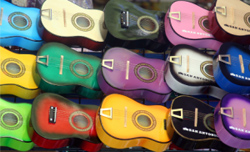
4. Volume too low. This happens as a result of a sound check in which the monitor levels of the guitar are set too high and thus the house mix set too low.
When it comes time for the service, the monitor mix volume is fine on the stage but isn’t loud enough to make up for the new dynamics in house due to the presence of the congregation and their singing along. The monitor mix should not be heard past the second or third row of seats in the sanctuary.
Stick with this rule and it will be obvious which volume you’re hearing.
5. Ye ol’ geetar strangs. Guitar strings are like the oil in a car. When the oil in the car gets old, your engine’s performance suffers. Old guitar strings are detrimental to a guitar sound.
This happens in two ways. The first is that old guitar strings come out-of-tune easily. Second, while they might be in tune, they sound bad. Think of it like looking at old oil that’s dark black and while you might say it’s still working in the car…does it look like something that would be working as effectively as possible in the car?
For this reason, if you hear guitarists with bad strings, talk with them about it and explain how it’s detrimental to the music.
6. Mixed alone. All instruments should be mixed together. And to explain that, let’s talk omelets. Crack a few eggs, add some sausage, add some onions, add some peppers, and now add salt and pepper.
The addition of salt and pepper might have just destroyed your perfect omelet. The reason is that all sausage is not the same. Some sausage is unseasoned. Other sausage has salt and seasoning already added. By adding salt to a recipe with an already salty sausage…well, you can just toss that omelet in the trash.
You can have instruments (ingredients) that individually sound great but when you put them together, the mix sounds terrible. Without going into a 20-page discussion on mixing instruments together, keep this key idea in mind; before you boost the frequency for one instrument to make it stand out, try cutting those frequencies from another instrument.
7. Poor presence. This might be the hardest area of mixing an acoustic guitar. A guitar mix can have a good sound but when compared to a mix where the sound guy nailed the presence, your mix sounds flat.
The best place to start is in the 1 kHz and 2 kHz areas. Boosting in these areas can give your guitar the fullness you desire. Mixing is an art so expect to spend some time working with these frequencies to find out what works for a particular guitar.
8. Mixing multiple guitars incorrectly. You don’t want the instruments to lose their individuality, but at the same time, you want to give a unique yet blended sound. This can be done through the use of EQ separation and pairing, panning, and through talking with the guitarists as to how they can create a well blended, yet different, sound using methods like bar chords and capos. I’ve covered this topic in depth here.
Mixing takes practice, and remember that the greatest live audio engineers started out knowing nothing about mixing.
Ready to learn and laugh? Chris Huff writes about the world of church audio at Behind The Mixer. He covers everything from audio fundamentals to dealing with musicians, and can even tell you the signs the sound guy is having a mental breakdown. To view the original article and to make comments, go here.
